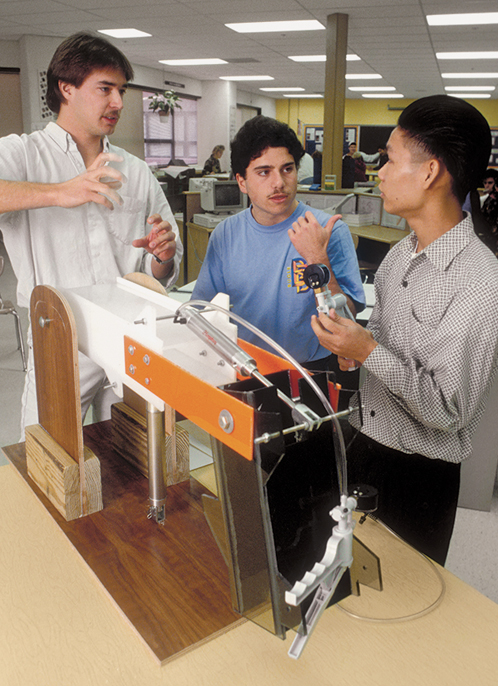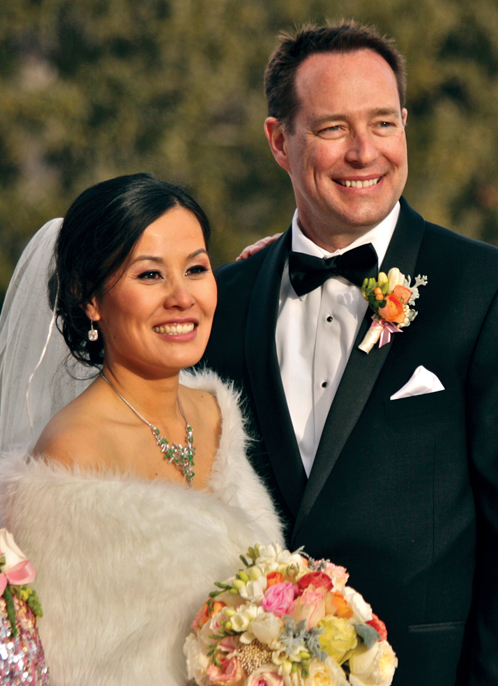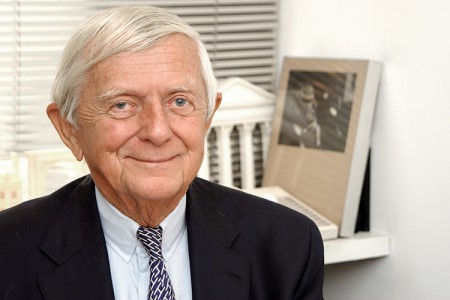Doctoring Up His Life Story
[rev_slider Romberg]
As Dr. Fred Romberg ’92 explains, his job as an anesthesiologist requires using potent pharmaceuticals and various high-tech gadgets to hijack the brain, heart, and lungs to control important vital signs like temperature, blood flow, and respiratory rate. He continually processes multiple patterns and waveforms to make such decisions, in essence, treating the human body as if it were a complex control theory problem.
So when he sits down at a piece of equipment designed to perform one of these functions and he can’t turn it on or change a setting, there is a problem. Does it take a rocket scientist to figure out this systems engineering conundrum?
Fortunately, Romberg, who holds a master’s in electrical engineering, is also a rocket scientist.
“I come from the space industry, where you think a lot about what you design before you build it. You run it through simulations and you get users to comment on it. Then you recreate and improve it based on user specifications. You design something that should work the first time. When it’s in deep space hurtling towards Mars, it better work.”
“Someone with an engineering background and a medical background has the potential to create very efficient and well-designed medical products,” says Romberg, who left a 12-year career at NASA’s Jet Propulsion Laboratory (JPL) at Caltech to enroll at Yale Medical School in 2006.
Romberg, 46, says his motivation was less midlife crisis—and more about working with people in crisis. In his last years at JPL, he counseled students at Caltech. He describes it as very gratifying work. “I now have the luxury of thinking about what will make me happy. Growing up in a single-parent home on welfare did not allow me to make my initial career choices based on passion or fulfillment. Instead, at an early age, practicality and survival were key motivators.”
At 16, he left high school and lived independently to escape an unstable home life. Mechanically gifted, he supported himself by working as an automotive and heavy truck mechanic for seven years. During this time, he earned a GED. After landing a job as the vehicle maintenance supervisor at Montgomery College in 1989, he enrolled at the Germantown Campus, initially taking remedial coursework.
 His supervisor, Ruth Henderson, gave him leave throughout the day to accommodate his class schedule, although he had to wear a beeper to respond to emergencies. While working full time, Romberg earned a 3.92 GPA—and an AA in engineering.
His supervisor, Ruth Henderson, gave him leave throughout the day to accommodate his class schedule, although he had to wear a beeper to respond to emergencies. While working full time, Romberg earned a 3.92 GPA—and an AA in engineering.
Professor Emeritus Ed Sereno, who taught Romberg at every math course he took at MC, from college algebra and trigonometry to calculus and differential equations, says, “I recognized early on that he had some very strong abilities and very high capacity.” Romberg sought out Sereno for transfer advice, and Sereno suggested the engineering program at Virginia Tech.
“It all started at Montgomery College. To this day, it holds a special place in my heart. People like Ed Sereno, Vince McManaman [physics professor emeritus], and many others helped me change my path in life in ways I never thought would be possible. I will never forget the incredible support and encouragement I received at MC.”
Romberg flourished at Virginia Tech. To help defray the cost of school, he received financial aid through a work-study program at Virginia Tech’s Satellite Communications Group. He later entered a co-op program, working summers at NASA’s Jet Propulsion Lab (JPL) at Caltech. Caltech offered Romberg a job at JPL after graduation, but he did attract interest from CIA recruiters.
In 1997 and 1998, he took two leaves-of-absence from JPL to work with the CIA in, as he puts it, “Technical aspects of foreign intelligence operations of interest to national security.” All he can divulge of his work with the CIA is extensive fieldwork and foreign travel; use of technical knowledge in liquid propulsion, guidance, and control; and flight test systems of specific foreign ballistic missiles. But his resume listing of the Clandestine Information Technology Office speaks volumes about his assignments.
Romberg, having acquired a great deal of knowledge about Scud missile systems in his first stint with the CIA, accepted a short assignment as a weapons inspector for the United Nations, Office of the Special Commission (UNSCOM) in Iraq.
“When we arrived by UN cargo plane in Baghdad, we were immediately surrounded by Iraqi military with weapons drawn,” he says. “It was a fascinating trip. The locals were very friendly and I explored another culture I may not have otherwise experienced.”
“I was a bit naïve about what I thought I would accomplish on these missions,” says Romberg, “but I’m always seeking out interesting experiences and try to ‘travel the path less taken’ when able.”
Romberg’s path often takes him to greater heights. His fascination with space and flight started at an early age. While at MC, Romberg was one of 44 students nationwide to participate in NASA’s Space Life Sciences Training Program at the Kennedy Space Center. At 22, Romberg received Federal Aviation Administration certification as a private pilot. He went on to obtain an instrument rating, as well as flight instructor and commercial pilot certificates. He befriended a fellow pilot while in graduate school at Caltech. The two lifelong friends co-own a Lancair Legacy, an experimental high-performance 370-horsepower, two-seater plane that Romberg built himself.
 Elaine Gee, whom Romberg met at Caltech, shared his interest in flying and helped with the three-year project. The two not only share nerdy hobbies, but also a curiosity to explore the world. Romberg calls Gee, a Harvard-educated PhD who works in next-generation DNA sequencing, his smarter half. On March 14, 2015 (the Pi Day irony is not lost on them), he made her his better half. Ed Sereno, recently ordained as a minister for this purpose, offi-ciated the wedding. Vince McManaman and Romberg’s best man, Kevin Roberts ’92, also represented the Montgomery College contingent.
Elaine Gee, whom Romberg met at Caltech, shared his interest in flying and helped with the three-year project. The two not only share nerdy hobbies, but also a curiosity to explore the world. Romberg calls Gee, a Harvard-educated PhD who works in next-generation DNA sequencing, his smarter half. On March 14, 2015 (the Pi Day irony is not lost on them), he made her his better half. Ed Sereno, recently ordained as a minister for this purpose, offi-ciated the wedding. Vince McManaman and Romberg’s best man, Kevin Roberts ’92, also represented the Montgomery College contingent.
“Marrying Elaine is one of the best decisions Fred made,” says Sereno. “And every decision Fred makes is well thought out and purposeful.”
Another example of Romberg’s methodical planning is his decision to help people in crisis. In his last years at JPL, Romberg was a resident associate at Caltech, providing counseling and crisis intervention to undergraduates. Romberg found the work immensely gratifying. “My passion for helping others was colliding with my intellectually stimulating, but less personally fulfilling career as an engineer.” His Caltech mentors, namely Dr. Alice Huang (who later became one of Romberg’s student pilots), encouraged him to parlay his engineering skills into a career in medicine.
When Romberg contemplated his transition to medical school, he enrolled at Occidental College to complete post-baccalaureate work in, among other subjects, organic chemistry and biology. He answered the bell with a 4.0 GPA, but his struggles with seemingly routine lab quizzes did not go unnoticed. One of his instructors, who had children with the same condition, suggested he might have dyslexia.
After testing revealed Romberg was both highly gifted (IQ in the 98th percentile) and dyslexic (reading speed in the 8th percentile), he obtained testing accommodations under the Americans with Disabilities Act for his Medical College Admission Test (MCAT). At Yale, Romberg requested, but was denied accommodations by the National Board of Medical Examiners (NBME) for the US Medical Licensing Examination (USMLE).
To appeal the decision of the NBME, Romberg enlisted the help of Dr. Sally Shaywitz, a leading dyslexia researcher and head of Yale’s Center for Dyslexia and Creativity. Shaywitz encouraged Romberg to file a complaint with the US Department of Justice (DOJ), which opened an investigation.
In a compelling letter written on Romberg’s behalf, as part of his final medical school evaluation summary, Shaywitz wrote: “Fred Romberg… presents with an unexpected difficulty in reading quickly and automatically; he is highly intelligent and dyslexic.… He is the sort of caring, thoughtful, compassionate, creative, and highly positive and forward-looking individual who can and will contribute substantially to medicine and the kind of individual whom medicine dearly needs.”
In the February 2011 settlement, the NBME agreed to give Romberg twice the usual testing time. “It was an enormous weight off my shoulders,” says Romberg. “I am extremely grateful to my mentors and colleagues at Yale and the folks at DOJ for their support. I hope these efforts will also benefit others in a similar situation. I thought my career in medicine was over—it was the longest year of my life.”
With a life full of stranger-than-fiction material, Romberg, now an anesthesiology resident at the University of Utah, is poised to launch his next career—and is ready to write the next chapter of his book. Although the ending remains uncertain, with all of Romberg’s intellectual pursuits and passion for helping people he will not have to “doctor up” the details.
[rev_slider RombergPlane]








Fred and his wife are tributes to this great country!